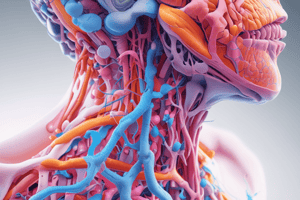Podcast
Questions and Answers
Contrast the terms endocrine, paracrine, autocrine, and neuroendocrine based on the site of release and the pathway to the target tissue.
Contrast the terms endocrine, paracrine, autocrine, and neuroendocrine based on the site of release and the pathway to the target tissue.
Endocrine: Hormones are released into the bloodstream and travel to distant target tissues. Paracrine: Hormones act on neighboring cells without entering the bloodstream. Autocrine: Hormones act on the same cell that produced them. Neuroendocrine: Hormones are released into the bloodstream by neurons and travel to target tissues.
Contrast peptide, steroid and amine hormones in terms of receptor location and signal transduction, solubility in blood and transport in blood.
Contrast peptide, steroid and amine hormones in terms of receptor location and signal transduction, solubility in blood and transport in blood.
Peptide hormones typically bind to cell surface receptors and use second messengers for signal transduction. They are water soluble and freely travel in the blood. Steroid hormones bind to intracellular receptors and act in the nucleus. They are lipid soluble and require carrier proteins for transport in the blood. Amine hormones may act on cell surface or intracellular receptors, and their solubility and transport depend on the specific amine hormone.
Explain the effects of hormone binding proteins (carriers) on access of hormones to their sites of action, degradation, and the regulation of hormone secretion.
Explain the effects of hormone binding proteins (carriers) on access of hormones to their sites of action, degradation, and the regulation of hormone secretion.
Hormone binding proteins can regulate the concentration of free hormones available to bind to receptors, affect hormone half-life by protecting hormones from degradation, and modulate hormone secretion by altering the amount of hormone bound to carriers.
Explain how endocrine cells act as signal integrators.
Explain how endocrine cells act as signal integrators.
Explain how negative feedback, feed-forward, and positive feedback systems work.
Explain how negative feedback, feed-forward, and positive feedback systems work.
Which hormone type is known for being soluble in blood and transported in blood without a carrier protein?
Which hormone type is known for being soluble in blood and transported in blood without a carrier protein?
What is the primary site of action for amine hormones?
What is the primary site of action for amine hormones?
Which hormone type is associated with binding proteins that regulate access to their sites of action and degradation?
Which hormone type is associated with binding proteins that regulate access to their sites of action and degradation?
In which system do negative feedback loops play a crucial role in maintaining hormone balance?
In which system do negative feedback loops play a crucial role in maintaining hormone balance?
Which term describes the release of hormones that act on neighboring cells in the same tissue?
Which term describes the release of hormones that act on neighboring cells in the same tissue?




